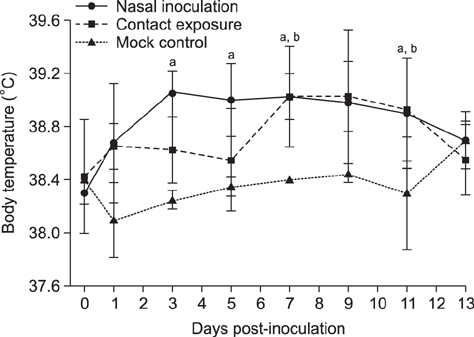J Vet Sci.
2017 Aug;18(S1):381-384. 10.4142/jvs.2017.18.S1.381.
Experimental infection of dogs with highly pathogenic avian influenza virus (H5N8)
- Affiliations
-
- 1Avian Disease Laboratory, College of Veterinary Medicine, Konkuk University, Seoul 05029, Korea. songcs@konkuk.ac.kr
- KMID: 2412563
- DOI: http://doi.org/10.4142/jvs.2017.18.S1.381
Abstract
- During the highly pathogenic avian influenza (HPAI) H5N8 virus outbreak in Korea, a dog in layer farm contaminated by H5N8 was reported seropositive for HPAI H5N8. To investigate the possibility of adaptation and transmission of HPAI H5N8 to dogs, we experimentally inoculated dogs with H5N8. Viral genes were weakly detected in nasal swabs and seroconversions in inoculated and contact dogs. Although the H5N8 virus did not induced severe clinical signs to dogs, the results suggest that surveillance of farm dogs should continue as a species in which the avian influenza virus may acquire infectivity to mammals through frequent contact with the virus.
MeSH Terms
Figure
Reference
-
1. Hai-xia F, Yuan-yuan L, Qian-qian S, Zong-shuai L, Feng-xia Z, Yan-li Z, Shi-jin J, Zhi-jing X. Interspecies transmission of canine influenza virus H5N2 to cats and chickens by close contact with experimentally infected dogs. Vet Microbiol. 2014; 170:414–417.
Article2. Horimoto T, Kawaoka Y. Influenza: lessons from past pandemics, warnings from current incidents. Nat Rev Microbiol. 2005; 3:591–600.
Article3. Imai M, Watanabe T, Hatta M, Das SC, Ozawa M, Shinya K, Zhong G, Hanson A, Katsura H, Watanabe S, Li C, Kawakami E, Yamada S, Kiso M, Suzuki Y, Maher EA, Neumann G, Kawaoka Y. Experimental adaptation of an influenza H5 HA confers respiratory droplet transmission to a reassortant H5 HA/H1N1 virus in ferrets. Nature. 2012; 486:420–428.
Article4. Jeong J, Kang HM, Lee EK, Song BM, Kwon YK, Kim HR, Choi KS, Kim JY, Lee HJ, Moon OK, Jeong W, Choi J, Baek JH, Joo YS, Park YH, Lee HS, Lee YJ. Highly pathogenic avian influenza virus (H5N8) in domestic poultry and its relationship with migratory birds in South Korea during 2014. Vet Microbiol. 2014; 173:249–257.
Article5. John TJ, Fulginiti VA. Parainfluenza 2 virus: increase in hemagglutinin titer on treatment with Tween-80 and ether. Proc Soc Exp Biol Med. 1966; 121:109–111.
Article6. Kuiken T, Holmes EC, McCauley J, Rimmelzwaan GF, Williams CS, Grenfell BT. Host species barriers to influenza virus infections. Science. 2006; 312:394–397.
Article7. Kuiken T, Rimmelzwaan G, van Riel D, van Amerongen G, Baars M, Fouchier R, Osterhaus A. Avian H5N1 influenza in cats. Science. 2004; 306:241.
Article8. Lee HJ, Kwon JS, Lee DH, Lee YN, Youn HN, Lee YJ, Kim MC, Jeong OM, Kang HM, Kwon JH, Lee JB, Park SY, Choi IS, Song CS. Continuing evolution and interspecies transmission of influenza viruses in live bird markets in Korea. Avian Dis. 2010; 54:1 Suppl. 738–748.
Article9. Lee YJ, Kang HM, Lee EK, Song BM, Jeong J, Kwon YK, Kim HR, Lee KJ, Hong MS, Jang I, Choi KS, Kim JY, Lee HJ, Kang MS, Jeong OM, Baek JH, Joo YS, Park YH, Lee HS. Novel reassortant influenza A(H5N8) viruses, South Korea, 2014. Emerg Infect Dis. 2014; 20:1087–1089.
Article10. Park JH, Lee KJ. [Detection of antibody against avian influenza in a dog, the first case of trans-species infection]. Explanation report. Sejong: Ministry of Agriculture, Food and Rural Affairs (KR);2006. Korean.11. Song QQ, Zhang FX, Liu JJ, Ling ZS, Zhu YL, Jiang SJ, Xie ZJ. Dog to dog transmission of a novel influenza virus (H5N2) isolated from a canine. Vet Microbiol. 2013; 161:331–333.
Article12. Songserm T, Amonsin A, Jam-on R, Sae-Heng N, Pariyothorn N, Payungporn S, Theamboonlers A, Chutinimitkul S, Thanawongnuwech R, Poovorawan Y. Fatal avian influenza A H5N1 in a dog. Emerg Infect Dis. 2006; 12:1744–1747.
Article13. Spackman E, Senne DA, Bulaga LL, Myers TJ, Perdue ML, Garber LP, Lohman K, Daum LT, Suarez DL. Development of real-time RT-PCR for the detection of avian influenza virus. Avian Dis. 2003; 47:3 Suppl. 1079–1082.
Article14. Subbarao K, Klimov A, Katz J, Regnery H, Lim W, Hall H, Perdue M, Swayne D, Bender C, Huang J, Hemphill M, Rowe T, Shaw M, Xu X, Fukuda K, Cox N. Characterization of an avian influenza A (H5N1) virus isolated from a child with a fatal respiratory illness. Science. 1998; 279:393–396.
Article15. Yuk SS, Lee DH, Park JK, To EO, Kwon JH, Noh JY, Gomis S, Song CS. Immune response in domestic ducks following intradermal delivery of inactivated vaccine against H5N1 highly pathogenic avian influenza virus adjuvanted with oligodeoxynucleotides containing CpG motifs. Poult Sci. 2015; 94:1836–1842.
Article
- Full Text Links
- Actions
-
Cited
- CITED
-
- Close
- Share
- Similar articles
-
- Pathogenicity of H5N8 virus in chickens from Korea in 2014
- Novel reassortants of clade 2.3.4.4 H5N6 highly pathogenic avian influenza viruses possessing genetic heterogeneity in South Korea in late 2017
- Recent outbreaks of highly pathogenic avian influenza viruses in South Korea
- Evolution, global spread, and pathogenicity of highly pathogenic avian influenza H5Nx clade 2.3.4.4
- H5N8 Highly Pathogenic Avian Influenza in the Republic of Korea: Epidemiology During the First Wave, from January Through July 2014


